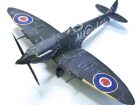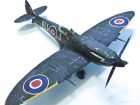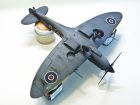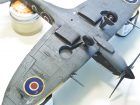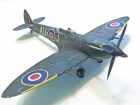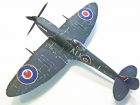Pastel wash…
With that out of the way, I move on to giving the underside a pastel wash. To make a pastel wash, I use some soft pastels (not oil pastels), some tap water, and some kitchen detergent liquid. I scrape some powder off the black and brown pastels using my craft knife to create a dark brown mixture. After adding some water and spreading it around, we have a consistent pigmented fluid. To this, I add just 4 drops of the detergent and mix it thoroughly. Then I brush it on to the entire underside of the aircraft and let it dry for 20 minutes. The idea behind this is that the wash settles in between the panel lines to simulate the accumulation of dust. But this method only leaves a subtle effect, so you might have to put down a few more layers to exaggerate the effect. I like it this way, but you can decide what you want to do on your own model.
With the wash wiped off and the underbody clear coated, we can glue the canopy on and attach the propellor. To paint the canopy, I don’t use any masks, so I do it by hand using a 00 sized round brush. You may do this but I’d only recommend it if you have a steady hand. You can use a liquid mask before painting too, that’s up to you.
A word of advice, when gluing on the canopy, it is wise to not apply the glue on the canopy directly. It’s near impossible to get the glue stains off clear plastic without damaging the piece entirely. What I do is, I take some glue out on a piece of plastic and put it on to the canopy using a toothpick. It doesn’t take too much glue for the canopy to stick firmly so the toothpick should do the trick.
Canopy glued in, propellor attached, we have a Spitfire! Looks ace, I’d say. What matters is that I’m happy with it, and I am. Because why even bother doing it if it doesn’t make you happy, right? I hope this has been educational or helpful in some way.
Cheers and happy modelling! Tally-ho!
Aadyan S.
Gallery
Below are a series of images of the completed model. Click on a thumbnail to see the enlarged image.

